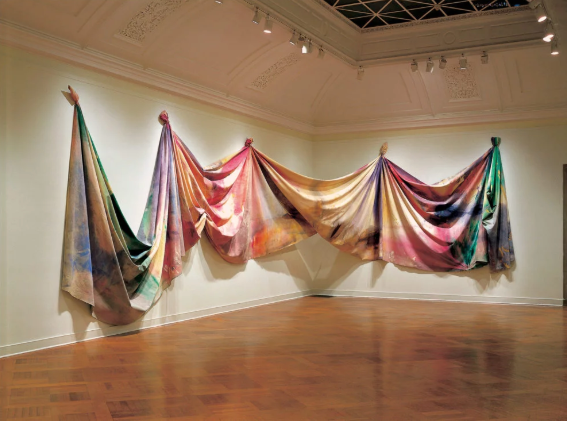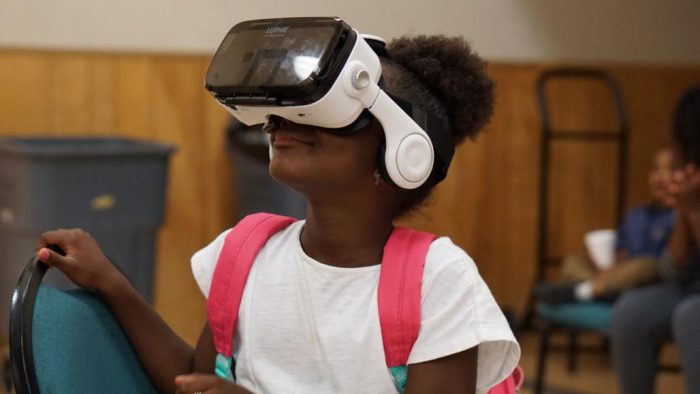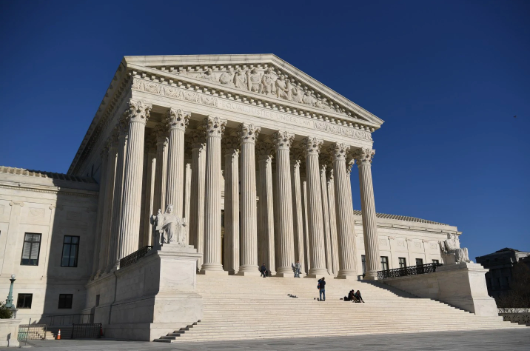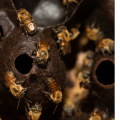ICYMI: Highlights from the week that was Feb. 1 – Feb. 7, 2020
No one can keep up with everything, so let us do it for you. We’ll gather the top Smithsonian stories from across the country and around the world each week so you’ll never be at a loss for conversation around the water cooler.
This week, news of online exhibitions and virtual reality led us to ponder a parallel universe where the President is also an expert in architecture.

Art and Design
A Major Sam Gilliam Retrospective Is Coming to the Hirshhorn
The DC artists is having a big moment
Washingtonian, February 7

Sam Gilliam, “Light Depth,” 1969. Acrylic on canvas. Courtesy Corcoran Gallery of Art. Gift from the Trustees of the Corcoran Gallery of Art (Museum Purchase, Gallery Fund), 2018.
Sam Gilliam, the renowned painter best known for his association with the Washington Color School, will take over the second floor of the Hirshhorn Museum in spring 2022. The show will be the first major American retrospective exhibit of Gilliam’s work in 15 years. Read more.
An Artist Born in 1933 Finds His Hottest Market in 2020
Sam Gilliam, who is 87, is on a market streak. A show at the Hirshhorn, planned for 2022, is likely to draw even more investor attention.
Bloomberg.com, February 6
In the spring of 2022, the Hirshhorn Museum and Sculpture Garden in Washington, D.C., will hold a retrospective of the abstract artist Sam Gilliam, his first major U.S. show in more than 15 years. Gilliam is best known for his brightly colored, unstretched canvases that hang from walls and ceilings—part paintings, part sculpture. Read more.
Smithsonian National Museum of African Art elects new advisory board members
Artforum, February 6

Mimi Alemayehou, Gay McDougall, and Gbenga Oyebode. Courtesy of the National Museum of African Art.
The Smithsonian’s National Museum of African Art in Washington, DC, has added three new members to its advisory board: Mimi Alemayehou, managing director of the Black Rhino Group; Gay McDougall, distinguished scholar-in-residence at the Leitner Center on International Law and Justice at Fordham University Law School; and Gbenga Oyebode, chairman of Aluko & Oyebode, one of the largest law firms in Nigeria. Read more.
Poised Between Two Worlds
This representation of Avalokiteshvara, known as Gwaneum in Korea, is a way station between tension and repose, between petitioners and gods.
The Wall Street Journal, January 31.
Poised Between Two Worlds – WSJ
History, Culture and Education
Smithsonian holds poignant memories for Navy aviator held captive in Vietnam
The Today Show (NBC), February 7
Kicking off a new series of reports on the treasures in “America’s attic,” the Smithsonian, Harry Smith profiles retired U.S. Navy Commander Al Carpenter, for whom one particular exhibit holds powerful memories: the clothes he wore during his more than six years of captivity in Vietnam. Watch the video.
This Startup Takes Kids on Diverse Field Trips With VR
Not every school can afford field trips to top museums, and those museums don’t always feature exhibits made for and by people of color. Curated x Kai aims to fix that by bringing experiences like the National Portrait Gallery’s Obama paintings into schools through VR.
PC Mag, November 7, 2019

(Photo: Curated x Kai, Inc.)
Major cities are full of cultural institutions, from museums to concert halls, but as Kai Frazier explains, “proximity does not mean access.”
Frazier, a former educator and museum professional, saw that access to and programs for these places were largely the provenance of white people. Even virtual tours included few people of color in front of or behind the camera. Read more.
Science and Technology
Watch Live Sunday: A Daring New Mission To Take Telescopes Closer To The Sun Than Ever Before
Forbes, February 6

Scheduled to launch in February 2020, ESA’s (European Space Agency’s) Solar Orbiter spacecraft is shown in an illustration against the backdrop of an image of the Sun captured by NASA’s Solar Dynamics Observatory. Solar Orbiter will capture the very first images of the Sun’s polar regions. These images will provide key insights into the poorly-understood magnetic environment there, which helps drive the Sun’s 11-year cycle and its periodic outpouring of solar storms. ESA/ATG MEDIALAB/NASA
The sun is our light-giver, our life-giver and, for astronomers, it’s a template for understanding all the other stars in the night sky.
In fact, much of what we know about stars in general comes from our studies of our sun, but there are massive gaps in our knowledge:
- The sun has an 11-year cycle, but why? What controls it?
- What drives the solar wind and “space weather?”
- How does the sun generate a magnetic field and how does it propagate through the sun’s atmosphere and outwards into space? Read more.
Various Subjects
Lonnie Bunch, the first African American Secretary of the Smithsonian, discusses his book ‘A Fool’s Errand’ (Video)
WUSA-9, February 6
Our Lesli Foster moderated a conversation with Dr. Bunch, at the Swiss Residence, on the creation of the National Museum of African American History & Culture. Watch.
With travelers unable to visit due to the coronavirus outreak, China’s museums put exhibitions online
CNN Travel, February 4

China’s National Cultural Heritage Administration has asked museums across the country, including Beijing’s Palace Museum, to offer digital tours.
NICOLAS ASFOURI/AFP/AFP via Getty Images
Chinese travelers can’t visit their country’s museums right now. So the museums are bringing the exhibits to them — virtually.
Museums around the country have been forced to temporarily close their doors due to the Wuhan coronavirus outbreak.
In response, China’s National Cultural Heritage Administration (NCHA) has asked them to stay active on social media and offer their services digitally. Read more.
Why Trump shouldn’t be allowed to dictate how federal buildings are designed
The Washington Post, February 6

The U.S. Supreme Court building, a classical Corinthian style, was completed in 1935. (Jonathan Newton/The Washington Post)
A little-known architectural design group is advocating new guidelines that could radically change the look and feel of federal buildings in the nation’s capital. The proposed executive order, circulating in draft form, mandates that new federal buildings, especially those in and around the District of Columbia, be built in “classical architectural style.” Read more.
Posted: 13 February 2020
-
Categories:
African Art Museum , American History Museum , Hirshhorn Museum , News & Announcements , Portrait Gallery








